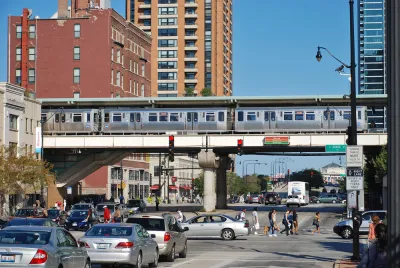The Equitable Transit-Oriented Development ordinance could advance equity and reduce car dependency, but the legislation faces resistance from some city council members.

An ordinance proposed by Chicago mayor Lori Lightfoot’s administration would encourage more transit-oriented development in the city. As John Greenfield writes in Streetsblog Chicago, “Equitable transit-oriented development – building generous amounts of affordable housing near rapid and/or high-frequency public transportation – is a powerful tool to reduce both segregation and car-dependency.” The Connected Communities Ordinance “builds on the city’s 2020 Equitable Transit Oriented Development Policy Plan, which outlined a comprehensive set of actions for officials to take over the next three years,” but the proposal faces opposition in City Council.
“While Streetsblog has been told city staffers are not allowed to share the latest draft of the ordinance, The Daily Line reported that Connected Communities includes almost a dozen measures to encourage transit-friendly housing and walkable streets near stations,” Greenfield reports. The ordinance would ease permitting for affordable housing developments and two- and three-flat housing near transit. “While Chicago typically requires a minimum number of car parking spots at new developments, according to The Daily Line the draft ordinance also included Chicago’s first parking maximum, a limit of no more than one space for every two apartments or condos.”
The ordinance has not yet been introduced to the city council. “Lightfoot recently explained that the legislation needs some more edits before it’s ready for its close-up.”
FULL STORY: Chicago’s proposed Equitable TOD ordinance would fight segregation and car-depedency

National Parks Layoffs Will Cause Communities to Lose Billions
Thousands of essential park workers were laid off this week, just before the busy spring break season.

Retro-silient?: America’s First “Eco-burb,” The Woodlands Turns 50
A master-planned community north of Houston offers lessons on green infrastructure and resilient design, but falls short of its founder’s lofty affordability and walkability goals.

Delivering for America Plan Will Downgrade Mail Service in at Least 49.5 Percent of Zip Codes
Republican and Democrat lawmakers criticize the plan for its disproportionate negative impact on rural communities.

Test News Post 1
This is a summary

Test News Headline 46
Test for the image on the front page.

Balancing Bombs and Butterflies: How the National Guard Protects a Rare Species
The National Guard at Fort Indiantown Gap uses GIS technology and land management strategies to balance military training with conservation efforts, ensuring the survival of the rare eastern regal fritillary butterfly.
Urban Design for Planners 1: Software Tools
This six-course series explores essential urban design concepts using open source software and equips planners with the tools they need to participate fully in the urban design process.
Planning for Universal Design
Learn the tools for implementing Universal Design in planning regulations.
EMC Planning Group, Inc.
Planetizen
Planetizen
Mpact (formerly Rail~Volution)
Great Falls Development Authority, Inc.
HUDs Office of Policy Development and Research
NYU Wagner Graduate School of Public Service





























